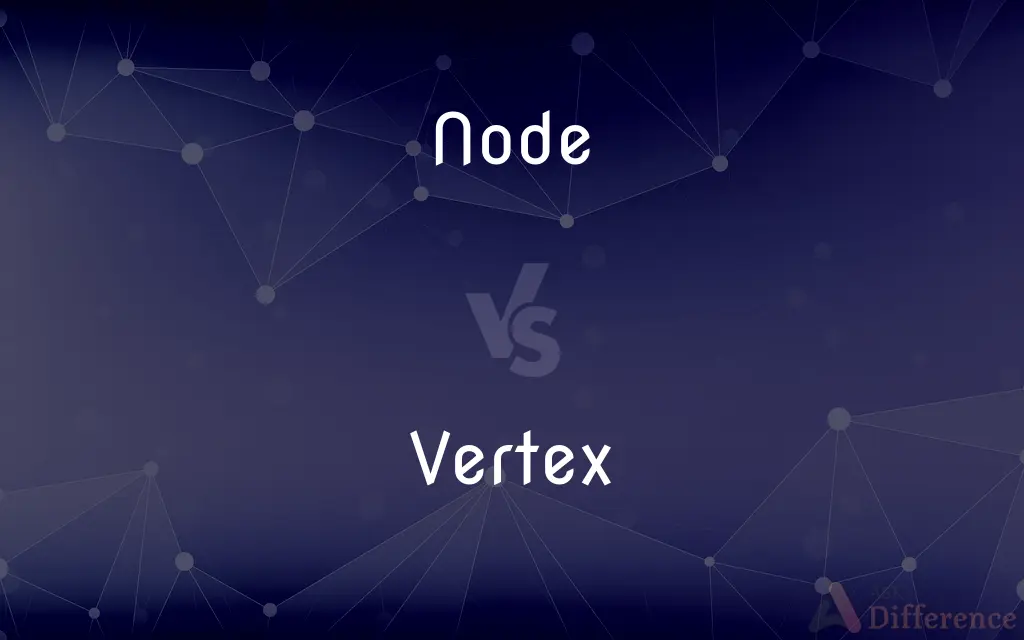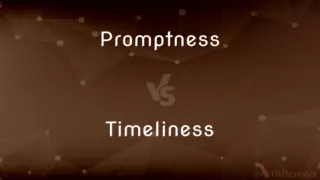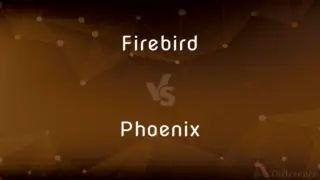Node vs. Vertex — What's the Difference?
By Tayyaba Rehman & Fiza Rafique — Updated on April 1, 2024
A node refers to a point in networks or data structures, while a vertex is a meeting point of edges in geometry or graph theory.

Difference Between Node and Vertex
Table of Contents
ADVERTISEMENT
Key Differences
Nodes are fundamental elements in various data structures, such as linked lists, trees, and graphs, as well as in network theory, where they represent points of intersection, connection, or interaction. Nodes can hold data and may connect to other nodes, indicating a relationship or pathway for data processing or communication. Vertex (plural: vertices), on the other hand, is a term primarily used in geometry and graph theory to denote the corner or a point where two or more lines, edges, or rays meet. In graph theory, a vertex serves a similar function to a node but is more often used in mathematical contexts to emphasize the points of intersection in geometric shapes or diagrams.
While both nodes and vertices are points of connection, the context in which they are used differs significantly. Nodes are typically discussed in the realm of computer science, information technology, and networking, highlighting their role in data or communication structures. Vertices are discussed in mathematical contexts, focusing on their geometric or spatial properties and relationships.
In computer science, especially in the field of graph theory, the terms node and vertex are often used interchangeably to represent points in a graph that are connected by edges. However, the choice of term can depend on the specific application or field of study, with "node" being preferred in computer networks and data structures, and "vertex" in mathematical discussions.
The concept of connectivity is central to both nodes and vertices. In networks, nodes might represent routers, computers, or other devices, connected by physical or virtual links. In geometry or graph theory, vertices are connected by edges or lines, representing geometric shapes or the relationships between points in a graph.
Understanding the distinction between nodes and vertices is crucial for grasping the basics of network theory, data structures, and geometry. While they perform similar roles in connecting points within their respective structures, the contexts and applications of nodes and vertices are what set them apart.
ADVERTISEMENT
Comparison Chart
Definition
A point in networks or data structures.
A meeting point of edges in geometry or graphs.
Primary Context
Computer science, information technology.
Geometry, mathematical graph theory.
Function
Hold data, connect to other nodes.
Point where edges meet, no data holding.
Usage
Data processing, networking.
Geometric shapes, graph relationships.
Interchangeability
Sometimes used interchangeably with "vertex" in graph theory.
Sometimes used interchangeably with "node" in graph theory.
Compare with Definitions
Node
A point in a network that can send, receive, or route data.
Each computer in the network is considered a node.
Vertex
A corner point in geometric shapes.
A square has four vertices, each being a corner where two sides meet.
Node
A junction point in circuits or systems.
Electrical circuits have nodes at junction points where currents converge.
Vertex
A point in graph theory where edges intersect.
This graph consists of vertices connected by edges to form a network.
Node
A point where data or control is processed.
Nodes in a distributed system work together to process tasks.
Vertex
In mathematical problems, a point of interest or analysis.
The solution involves finding the distance between two vertices on the graph.
Node
In networking, a device connected to the network.
The network diagram shows nodes representing routers and switches.
Vertex
In computer graphics, a point defining the shape of an object.
The model's surface is made up of vertices connected by edges.
Node
An element in data structures like trees or graphs.
The binary tree has nodes containing values and pointers.
Vertex
In topology, a point marking the end of a line segment.
Line segments in a topological space meet at vertices.
Node
A knob, knot, protuberance, or swelling.
Vertex
The highest point; the top or apex.
Node
(Medicine) A small, well-defined mass of tissue that is either normal or pathological, as a lymph node or a node at an arthritic joint.
Vertex
Each angular point of a polygon, polyhedron, or other figure.
Node
A point or area where two lines, paths, or parts intersect or branch off
"The nodes, or branching points, are usually demarcated by sets of one or more new, evolutionary characters that typify all taxa" (Pat Shipley).
Vertex
The highest point; the apex or summit
The vertex of a mountain.
Node
A focal point or a point of interaction
"Inside the hospital, she became a node of gossip, despite being unable to communicate in the usual way" (Oliver Sacks).
Vertex
The highest point of the skull.
Node
(Botany) The point on a stem where a leaf is attached or has been attached; a joint.
Vertex
The top of the head.
Node
See knot1.
Vertex
In astrology, the highest point reached in the apparent motion of a celestial body.
Node
(Physics) A point or region of virtually zero amplitude in a wave or periodic system.
Vertex
The point at which the sides of an angle intersect.
Node
(Mathematics) The point at which a continuous curve crosses itself.
Vertex
The point on a triangle or pyramid opposite to and farthest away from its base.
Node
(Computers) A terminal in a computer network.
Vertex
A point on a polyhedron common to three or more sides.
Node
Either of two diametrically opposite points at which the orbit of a planet intersects the ecliptic.
Vertex
A point of maximal curvature on a parabola or hyperbola.
Node
Either of two points at which the orbit of a satellite intersects the orbital plane of a planet.
Vertex
The highest point, top or apex of something.
Node
A knot, knob, protuberance or swelling.
Vertex
(anatomy) The highest surface on the skull; the crown of the head.
Node
(astronomy) The point where the orbit of a planet, as viewed from the Sun, intersects the ecliptic. The ascending and descending nodes refer respectively to the points where the planet moves from South to North and N to S; their respective symbols are ☊ and ☋.
Vertex
(geometry) An angular point of a polygon, polyhedron or higher order polytope.
Node
(botany) A leaf node.
Vertex
The common point of the two rays that form an angle.
Node
(networking) A computer or other device attached to a network.
Vertex
The point at which an axis meets a curve or surface.
Node
(engineering) The point at which the lines of a funicular machine meet from different angular directions; — called also knot.
Vertex
(mathematics) A point on the curve with a local minimum or maximum of curvature.
Node
(geometry) The point at which a curve crosses itself, being a double point of the curve. See crunode and acnode.
Vertex
(graph theory) One of the elements of a graph joined or not by edges to other vertices.
Node
(geometry) A similar point on a surface, where there is more than one tangent-plane.
Vertex
(computer graphics) A point in 3D space, usually given in terms of its Cartesian coordinates.
Node
(graph theory) A vertex or a leaf in a graph of a network, or other element in a data structure.
Vertex
(optics) The point where the surface of a lens crosses the optical axis.
Node
(medicine) A hard concretion or incrustation which forms upon bones attacked with rheumatism, gout, or syphilis; sometimes also, a swelling in the neighborhood of a joint.
Vertex
(particle physics) An interaction point.
Node
(physics) A point along a standing wave where the wave has minimal amplitude.
Vertex
(astrology) The point where the prime vertical meets the ecliptic in the western hemisphere of a natal chart.
Node
(rare) The knot, intrigue, or plot of a dramatic work.
Vertex
(typography) A sharp downward point opposite a crotch, as in the letters "V" and "W" but not "Y".
Node
(technical) A hole in the gnomon of a sundial, through which passes the ray of light which marks the hour of the day, the parallels of the Sun's declination, his place in the ecliptic, etc.
Vertex
A turning point; the principal or highest point; top; summit; crown; apex.
Node
(computational linguistics) The word of interest in a KWIC, surrounded by left and right cotexts.
Vertex
The top, or crown, of the head.
Node
(electronics) A region of an electric circuit connected only by (ideal) wires (i.e the voltage between any two points on the same node must be zero).
Vertex
The zenith, or the point of the heavens directly overhead.
Node
A knot, a knob; a protuberance; a swelling.
Vertex
The point in any figure opposite to, and farthest from, the base; the terminating point of some particular line or lines in a figure or a curve; the top, or the point opposite the base.
Node
One of the two points where the orbit of a planet, or comet, intersects the ecliptic, or the orbit of a satellite intersects the plane of the orbit of its primary.
Vertex
The point of intersection of lines or the point opposite the base of a figure
Node
A special point in a graph or diagram which is attached to other points by links. It is often labeled and represented graphically as a box or circle. A node may represent any object which is related to other objects in a conceptual structure that can be represented as a graph, the relations being represented as links between the nodes.
Vertex
The highest point (of something);
At the peak of the pyramid
Node
A small mass of tissue differing from other tissue in its immediate vicinity; as, a lymph node.
Node
A connecting point at which several lines come together
Node
Any thickened enlargement
Node
(physics) the point of minimum displacement in a periodic system
Node
(astronomy) a point where an orbit crosses a plane
Node
The source of lymph and lymphocytes
Node
Any bulge or swelling of an anatomical structure or part
Node
(computer science) any computer that is hooked up to a computer network
Common Curiosities
What role do nodes play in networks?
In networks, nodes can send, receive, or route data, acting as points of communication or processing.
Can the terms node and vertex be used interchangeably?
Yes, in graph theory, the terms can be interchangeable, though their usage may depend on the field of study.
What is a vertex?
A vertex is a meeting point of edges in geometry or graph theory, often referring to the corners of geometric shapes or points in a graph.
How do nodes and vertices differ in context?
Nodes are primarily used in computer science and networking contexts, while vertices are used in geometry and mathematical graph theory.
How do vertices function in graph theory?
Vertices represent points in a graph that are connected by edges, forming the structure of the graph.
What is a node?
A node is a fundamental element in networks or data structures, representing points of connection, interaction, or data processing.
Do nodes hold data in all contexts?
In many contexts, such as in data structures or networks, nodes can hold data or information.
Can a point in a geometric shape be called a node?
While typically called a vertex, in the broader context of graph theory applied to geometry, it might also be referred to as a node.
What differentiates a vertex in computer graphics?
In computer graphics, a vertex defines the shape and surface of 3D models, connected by edges to form the object's mesh.
What significance do vertices have in geometry?
Vertices mark the points where edges of geometric shapes meet, defining the shape's corners and structure.
Is a router considered a node or a vertex?
In the context of networking, a router is considered a node because it routes data between different points in the network.
Why might someone choose to use "node" over "vertex" in a discussion?
The choice can depend on the context: "node" in discussions about networks or data structures, and "vertex" in geometric or mathematical contexts.
What is the importance of distinguishing between nodes and vertices?
Understanding the distinction is crucial for accurately communicating concepts in computer science, networking, and mathematics.
How do nodes and vertices contribute to the understanding of graphs?
Both are essential for understanding the structure and relationships within graphs, whether in computer science or mathematics.
Are there scenarios where vertices have data associated with them?
Yes, in some graph theory applications, vertices can have associated data or weights, especially in weighted graphs or networks.
Share Your Discovery

Previous Comparison
Promptness vs. Timeliness
Next Comparison
Firebird vs. PhoenixAuthor Spotlight
Written by
Tayyaba RehmanTayyaba Rehman is a distinguished writer, currently serving as a primary contributor to askdifference.com. As a researcher in semantics and etymology, Tayyaba's passion for the complexity of languages and their distinctions has found a perfect home on the platform. Tayyaba delves into the intricacies of language, distinguishing between commonly confused words and phrases, thereby providing clarity for readers worldwide.
Co-written by
Fiza RafiqueFiza Rafique is a skilled content writer at AskDifference.com, where she meticulously refines and enhances written pieces. Drawing from her vast editorial expertise, Fiza ensures clarity, accuracy, and precision in every article. Passionate about language, she continually seeks to elevate the quality of content for readers worldwide.
















































